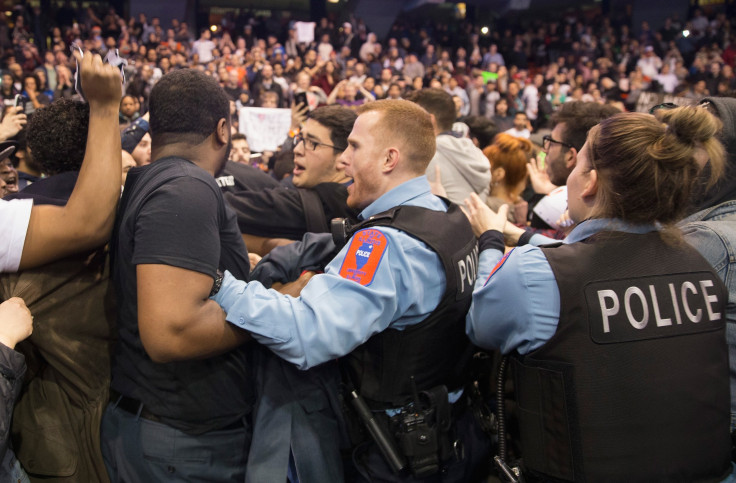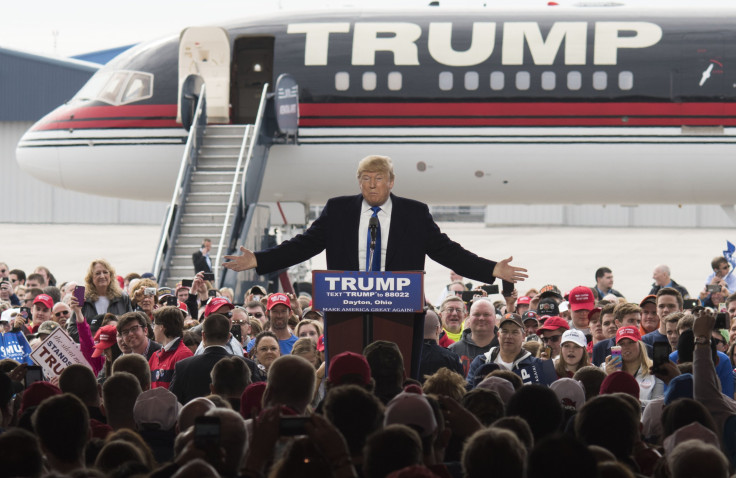‘Someone Will Die’: Violence At Trump Rallies Unnerves Media

Donald Trump took a gulp of his own medicine on Saturday. Perched behind his podium at a rally in Ohio, his private jet in the background, the mogul was interrupted midsentence by a bearded protester who attempted to rush the stage. Video of the event shows a sweaty-faced Trump whip his head around and grope for his bodyguards, rocking the podium as he ducks for cover while the demonstrator is speedily apprehended by Secret Service.
The moment came a day after Trump canceled a rally in Chicago where protesters crashed the event and scuffles broke out across the crowd. It came a few days after a reporter for Breitbart News, Michelle Fields, filed charges against Trump’s campaign manager, who she said manhandled her at a campaign event. It came two weeks after Trump’s security assaulted a Time photographer, again on video, in Virginia. It came after months of black protesters getting pushed and punched at Trump rallies, and after a hate crime against a Hispanic man in Trump’s name.
Violence, in other words, is the latest trend story this election season. But now that the violence has crept up to his own podium, Trump isn’t the only one who looks rattled: The media class, and many Americans as a whole, are feeling genuine, palpable fear.
The tables have turned: Trump is visibly terrified of disruptions at his rallies now https://t.co/Hkquh1vvZe
— brendan james (@deep_beige) March 12, 2016
Vox's Matt Yglesias, who until this weekend has taken pride in treating Trump as a purely sociological phenomenon, admitted on Sunday that now he's just flat-out scared. “I can't be contrarian about Donald Trump anymore: He's terrifying,” the blogger wrote.
New York magazine’s Jonathan Chait, too, recanted his position that Trump was a “vaccine” for the Republican Party and now declares that he must be beaten at all costs. “He is spreading poisons throughout the system that could linger beyond his defeat. Anybody who cares about the health of American democracy should hope for its end as swiftly as possible.”

Talking Points Memo’s Josh Marshall, another liberal commentator, was even more ominous in his Saturday post titled, “Someone Will Die.” “He is drawing in, like moths to a flame, those who most want to act out on their animosities, drives and beliefs,” Marshall wrote. “It is the kind of climate where someone will eventually get killed.”
Marshall, Chait and other liberals appear jittery not only about Trump’s supporters — many of whom are on record as comfortable with violence , white supremacy, anti-Semitism and racism — but the anti-racist leftist protesters who are now demonstrating against him. They share concerns with conservatives like Bloomberg’s Megan McArdle, who considers it a “terrible, illiberal” tactic to shut down a rally.
“The left needs to try to police its protesters, not because they’re responsible for Trumpkin actions, but because Trump obviously won’t lead,” she tweeted on Sunday.
McArdle’s more die-hard conservative colleagues, like Dan McLaughlin of RedState (aka “Baseball Crank”) are more old-fashioned in their criticism. “[D]on't let the Left act all innocent,” he tweeted of the protesters. “The anti-Trump goons who showed up to brawl with the Trump goons? They were already goons.”
Cable news coverage began to reach a fever pitch: During the aborted rally on Friday, each channel blasted out aerial shots of the scene in Chicago. CNN filled its screen time with rambling commentary while Fox News delivered a fawning emergency call-in interview with Trump.
The breathless coverage was reminiscent of the media’s palpable anxiety during the unrest in Ferguson and Baltimore. It’s a sense that things aren’t going according to plan, the sense that politics belongs in a split-screen on TV, not out in the streets.
Trump, meanwhile, recovered from his moment of sweaty panic and is playing tough guy again, threatening to send a bunch of rowdy supporters over to Bernie Sanders, whom he blames for organizing Friday's dustup. (He also told NBC he'll pay the legal bills of his violent fans.)
Up until now, there’s been a lot of theoretical debate about Trump: his inexplicable insurgency, his rhetoric and whether he’s merely an opportunist or a full-blown fascist. But Friday’s chaos has injected this debate with urgency. Reporters are afraid of getting clotheslined at a Trump rally. Think piece writers wonder whether America is going to re-enter the vortex of the '60s and '70s, years peppered with assassinations, bombings, riots and upheaval. The candidates themselves must be wondering what lies in store.
Whatever that is, it will be televised.
© Copyright IBTimes 2024. All rights reserved.






















